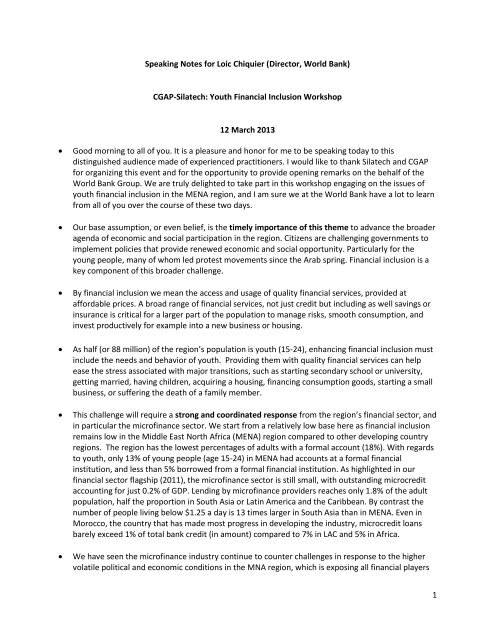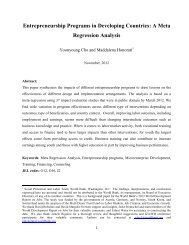Loic Chiquier-WorldBank-Keynote-MENA Youth FI Workshop-2013.pdf
Loic Chiquier-WorldBank-Keynote-MENA Youth FI Workshop-2013.pdf
Loic Chiquier-WorldBank-Keynote-MENA Youth FI Workshop-2013.pdf
You also want an ePaper? Increase the reach of your titles
YUMPU automatically turns print PDFs into web optimized ePapers that Google loves.
Third, operational inefficiencies amongst M<strong>FI</strong>s are in part the result of underdeveloped financialinfrastructure. Generally many M<strong>FI</strong>s are not integrated into the formal credit information system.Credit assessment and risk management techniques of many lenders-– not just M<strong>FI</strong>s- tend to beoutdated, implying that lenders often have to rely on collateral that is expensive to register and maynot be readily enforceable. <strong>MENA</strong> has the lowest score on the Doing Business Legal Rights index ofany world region. As a result, financial institutions face higher levels of credit risk, and tend toremain quite conservative. Yet we have seen encouraging progress in that space. Fourth, consumer protection and financial literacy efforts in the region are relatively nascent. Of 11<strong>MENA</strong> countries that responded to the 2010 CGAP and World Bank Financial Access survey, 7 hadintroduced consumer protection reforms, indicating that <strong>MENA</strong> is getting in line with global trends.However, many M<strong>FI</strong>s in the region have developed consumer protection and financial responsibilitycodes on a voluntary basis, as seen through members of the regional network Sanabel signing aconsumer protection and responsible finance document in 2008.Addressing the high levels of financial exclusion in <strong>MENA</strong> will require coordinated and concertedaction on behalf of governments, policymakers and researchers, in addition to local communities.The critical questions we must ask are: 1) what policies are needed to ensure the microfinancesector develops sustainably and inclusive of important target groups such as youth? And 2) how toimplement these policies effectively?First, there is a need to improve the legal, regulatory, and institutional environment formicrofinance institutions. On the regulatory front, laws must be implemented that provide clearguidelines for M<strong>FI</strong> operations and balance consumer protection with the ability of the sector togrow and innovate. Amending regulations to allow for a full suite of financial services includingdeposits and insurance would be an important place to begin.Similarly, critical investments in financial infrastructure improve the environment for microfinance.Credit reporting can help manage risks and promote innovation. In particular, developing platformsto track credit information on mobile phones can help expand mobile banking, which could growfast given the number of young people with mobile phones in <strong>MENA</strong>. Other investments neededinclude enhancing credit bureaus across the region, expanding payment systems, improving depositinsurance schemes, and upgrading physical infrastructure to access rural clients. Such reformsreduce the cost of delivering financial services to the underserved groups.At the institutional level, significant work is needed to enhance the capacity of providers, M<strong>FI</strong>s,banks and NB<strong>FI</strong>s, to operate sustainably and offer quality products that meet the financial needs ofthe youth. Assistance can include developing effective risk management and internal controlssystems, training key staff members such as loan officer and senior management, developingeffective supervision and reporting systems, and developing products that are in demand. The WBGsupports these efforts through a regional approach (<strong>MENA</strong> MSME TA facility). Access is also a keyobjective of our new Arab Housing Finance Initiative in partnership with the Arab Monetary FundThere is a need to develop the capacity for growth and innovation of micro and small entrepreneurs.We know that MSMEs typically account for 20% to 40% of all employment in <strong>MENA</strong>. We also knowthat 10-15% of SMEs create 50-80% of new jobs in the region. These entrepreneurs, however, arelargely finance constrained (only 8% of total bank lending is to SMEs; 2% for GCC countries) and3
often lack the support necessary to manage the red tape around starting and growing a business. Anecosystem most hospitable to micro-entrepreneurs is needed to help young entrepreneurs getaccess to the knowledge, finance, and networks necessary to allow innovative ideas to turn intobusiness success stories. A recent WB project in Lebanon aims to do just this. The project willprovide US$2.5 million for Concept Development Grants (CDGs) to microentrepreneurs; andUS$25million for equity investment in Seed, Early/Venture, and Growth stage firms. We also promoteMSMEs in Yemen, where a $4.9 million dollar project will provide 400 firms with matching grants forbusiness development as well as providing up to 400 fresh college graduates internship programs.In addition to this operational front, strategic investment in research and data is needed,particularly research that analyzes why the demand, usage, and access to microfinance servicesremains so low in <strong>MENA</strong>. The World Bank Group is currently embarking on such a demand-sidestudy of financial exclusion amongst women and youth across North Africa in order to betterunderstand what interventions are needed to bring them into the formal financial sector. We lookforward to working with our colleagues across the academic, donor, and NGO community onbridging knowledge and action through research that addresses key market gaps in <strong>MENA</strong>.Financial sector development in the region will increasingly have to move beyond the purview of themicrofinance model alone, instead working with a variety of providers, from community-basedsavings groups to postal banks to promote an integrated vision for financial inclusion.The past decade has seen some successful cases where postal outlets have been used to providefinancial services to the rural poor on an impressive scale. In Brazil, Correios (the postal operator)and Bradesco’s (the largest private retail bank) strategic partnership started in the early 2000s andresulted in 11 million new banking accounts opened over 10 years. In Morocco, Al Barid Bank (postalbank) was created in 2010 as a subsidiary of Poste Maroc. Since then, we understand that the postalbank opened close to 500,000 accounts per year and now has more than 6 million accounts. Forthose customers, the main difference lays in the ability to borrow from Al Barid Bank, somethingthat they could not do before with Poste Maroc. Lower income banking has also started to attractthe attention of commercial banks, which have discovered potential of lower-income banking andinvested into dedicated units with adapted delivery models. Morocco is an interesting example towatch, with several banks launching targeted product packages for the under-served groups.For all key stakeholders involved in financial inclusion in <strong>MENA</strong> there is a pressing need to learnfrom peers and best practices in other world regions on practices that have broken cost, technology,and innovation barriers.o On product innovation and youth currently M<strong>FI</strong>s in Africa (Uganda, Burundi, and theDemocratic Republic of the Congo), Asia (Mongolia), and Latin America (DominicanRepublic) have been successful at implementing youth savings accounts on a widespreadbasis. For example, in Mongolia, XacBank has opened over 7,000 savings accounts for girlsaged 14-24 and has over 18,900 girls enrolled in financial literacy trainings. We have onepromising example in the region with Al-Amal Bank in Yemen offering loans, savings, andfinancial education to youth under 30. Much more is needed.oWith regards to financial literacy the Brazil financial education project – whichimplemented financial education modules in 900 schools coupled with parent financialliteracy workshops - has raised students’ savings rates by 24% and increased the percentageof parents who track monthly expenses by 17%. The program is set to be rolled out4
nationally based on the positive results of these pilots. All financial regulators workedactively with the financial industry to improve consumer protection and financial literacyprograms. Our <strong>MENA</strong> counterparts can learn from these examples.oMobile banking is also opening immense opportunities for accessing the rural poor on acost-sustainable basis. In Kenya, the M-PESA initiative, with over 16 million customers is aniconic story. The <strong>MENA</strong> region boasts over 250 million mobile subscriptions - 72% ofpopulation. Providing the regulatory and market incentives necessary to create a robustmobile-banking sector is an important challenge moving forward.oFinally, one key success factor of any successful financial inclusion strategy is the capacity to bringtogether disparate efforts into a coordinated sum. The Moroccan authorities are launching a projectthat the World Bank will support to develop a comprehensive financial inclusion strategy, bringingtogether important initiatives under the Banque-Al-Maghrib, the Ministry of Finance, the Ministry ofEducation, the microcredit industry, banks, insurers, micro lenders and many others to chart acomprehensive roadmap to enhance financial access. The project also works to improve the legal,regulatory and institutional framework for the microfinance industry through building marketinfrastructure for M<strong>FI</strong>s and microenterprises and financial literacy trainings.In conclusion, the future of the <strong>MENA</strong> region lies in effectively creating economic and socialopportunity for the region’s youth. A robust financial sector that supports innovation, growth, andinclusion is an important part of this process. I wish you the best over the next two days. I am surethat the sessions will provide important insights on how to tackle this challenge. From our end, welook forward leaning a lot from your respective experience, as the collective knowledge in this roomis impressive.5
















